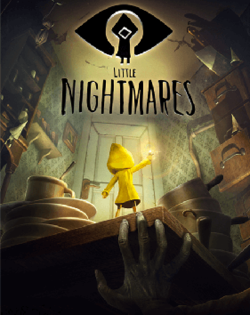
I have mixed feelings towards Little Nightmares, because as a player, I don’t treasure the moments of extreme frustration, even if the outcome of overcoming the challenge seems to be promising. As game designers, our goal is to entertain, so flirting with negative emotions and responses is always a risk.
However, the way I see it, it’s the way designers deal with strong emotions what makes this game so memorable. And it’s not just about designing puzzles that are difficult to overcome, but also about the pacing, the variations and echoes that surround those puzzles.
There are many great mechanics and small details that left an imprint on me, but I’ll just try to scratch the surface with some of the ones I found more meaningful on a narrative level.
Anticipation
Every good torturer knows the potential psychological impact of tuning up the torture tool set in front of the victim even before the party starts.
In Little Nightmares, we some times get open shots between chapters where we see a distant blurry silhouette not explicitly harming.
 Anticipation has always been a recurrent resource in horror films, so for example, you’ll always get the typical build up music that climaxes on an epic scare that usually ends up being just a false alarm.
Anticipation has always been a recurrent resource in horror films, so for example, you’ll always get the typical build up music that climaxes on an epic scare that usually ends up being just a false alarm.
An interesting variation I found very effective in Little Nightmares is that even though the silhouettes are so far away, and you’re safe at that moment, the emotional impact is enormous. I think the potential relies on the fact that you always see those shapes heading towards the same direction as you, so there’s an implied promise that the threat doesn’t care about now. It knows it will get you eventually.
Peaks and valleys
The way I see it, it’s that friction between security and danger where the emotional appeal come from in this game.
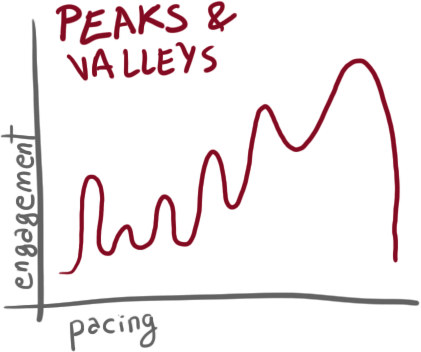
You might know the basics behind the interest curve formula, which is a more or less standard in all forms of story-telling. According to it, people feel the strength of an emotion always in comparison to a standard. So it’s our duty, as game designers, to set up timing, pace, and impact so that the experience brings the player deep enough into his emotions.
That’s the reason why, after moments of fear or dread, we relish the small breathers between puzzles so strongly, even when we know they won’t last for long.
The designers of Little Nightmares, however, didn’t renounce to give this dynamics a twist. There’s probably only one way in which you know you’re completely save in this game, and that’s when you sneak into pipelines. At some point, however, this happens:
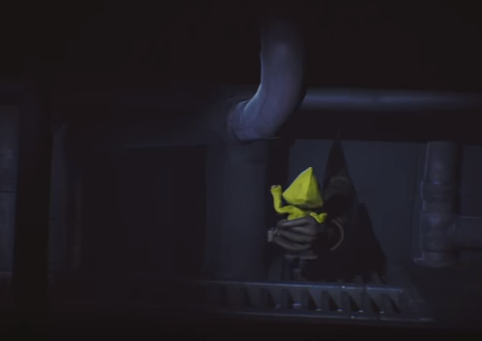
The only safe hideout for the hero is unexpectedly invaded, an irreversible twist in the status quo that wrecks the player assumptions and expectations from that moment and until the end of the game.
Pointing at danger
I personally don’t like it where the resolution of a puzzle depends purely on trial and error, which means that the way it was designed didn’t give you the chance to anticipate it to avoid failure.
For some reason, the designers of Little Nightmares chose to keep high levels of frustration at some points, but the truth is that most of the times, even though the puzzles might be difficult, they help us out by showing where the danger is.
Blurry showing distance
Here’s a visual effect that’s subtle but effective. Some times, when you’re inside the same frame as a bad guy but on a different depth level, a blur effect will be applied to him to show you if you’re into his focus or not.

Apart from helping the player, this effect is another way to build up to the imminent scare you’ll get when the enemy inevitably notices you.
Repeating the cycle
This is a common resource in games with mechanics based on stealth. Basically, you memorize the patterns behind the enemies paths so that you can sneak in without being noticed.
Bad part is, I think, that too much predictability might actually make the player get the impression the enemies are robots and so, the experience renders superfluous.
What can be done then? Adding little variations in the paths and behaviors that are somehow predictable by themselves might be way harder to develop in many ways. Designers and programmers will need to implement a logic including a bigger specter of cases, and animators will need to put extra care so that all animations fit smoothly and make visual sense.
I found the AI for enemies in Little Nightmares was pretty well achieved, specially in scenes like the ones that take place in the kitchen, where the setup of the environment by itself already give you material to plan and react.

Rising stakes (what could happen if…)
Another way to show you how you can, or how you shouldn’t even try to solve a puzzle is by drafting potential outcomes in the environment, which at the same time boosts the player’s levels of discomfort.
There are many examples in this game. For instance, you’ll see the typical children all wrapped up and ready to be eaten around the kitchen, or more indirect but powerful identification devices, like this one:
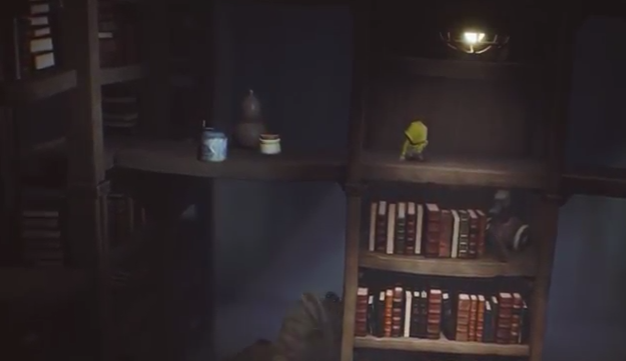
There are lots of chances you’ll stumble upon those pots as you go along the shelve making them fall to the ground and shatter to pieces. You won’t shatter to pieces if you fall from there, but… do you see the head of that guy who’s waiting below?
Meaningful variations
I was actually impressed by the level design behind the library scene. It’s simple and yet efficient, and you know from the beginning that everything’s there for a purpose.
Without entering into details, you need to go from A to B and then back to A without the long-armed fella getting you. So when you’re halfway your way back and you know the enemy was left behind, the run animation of the hero spontaneously varies and for a couple of cycles it changes to the typical movement of looking back to see if there’s someone behind you.
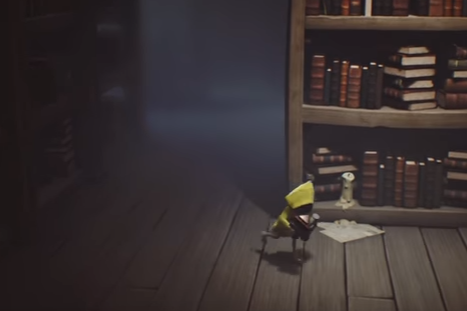
That little moment gave me the creeps. I wasn’t expecting it at all, and I was actually pretty confident that the enemy was really far away. But at that precise moment, all my assumptions where shattered. I was still halfway to the exit, so if the creature came, he’d get me for sure.
In the end, nothing really happened until later on, which in my opinion, made it even more unsettling.
Meaningful repetitions
Taking small beats of story or common places and repeating them over the chapters bring the meanings to a whole new level.
What’s more, recurrent structures in this game empower the sensation of confinement and isolation that matches the theme and main story line on a literal level as well.
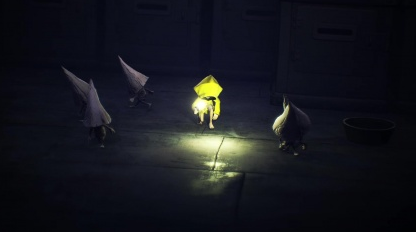
For example, every once in a while, our little yellow-hooded hero will start writhing of starvation for no apparent reason at all. Every time that happens, the kid will end up getting something to eat, but always in a different way.
Even though the meaning of these story beats might be open to interpretation and cause even more anxiety to the player, when we see those moments coming, we feel engaged to a somehow familiar terrain, a subjective construction shaped by our previous experience and hopes that a meaning will eventually unveil in future occurrences.
The magic formula
I just scratched the surface of a thick and wide layer of narrative inventive the game designers spread over Little Nightmares.
Dealing with negative emotions in Game Design might actually sound counter intuitive, since all our experience, and the short theoretical tradition we’ve gathered so far, urges us to aim for fun.
So despite the criticized difficulty of puzzles and the frequent resort to trial and error, I think there’s something reckless and ground-breaking about this kind of games. Dealing with discomfort and anxiety is a less frequented terrain, which usually leads to new interesting opportunities.
Leave a Reply